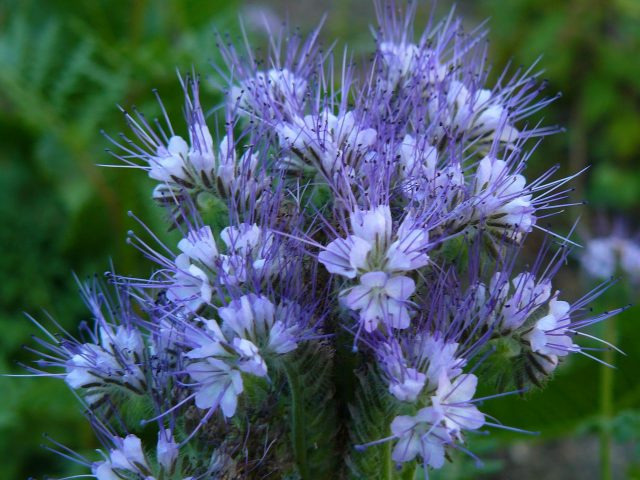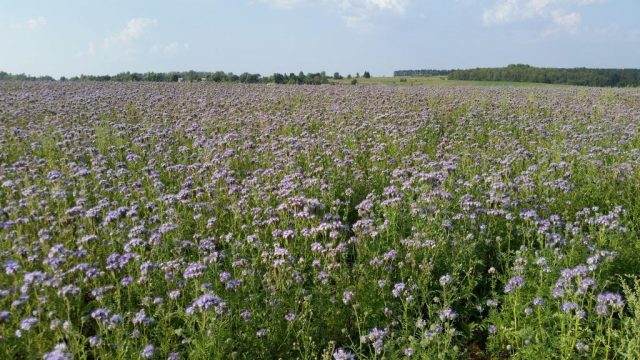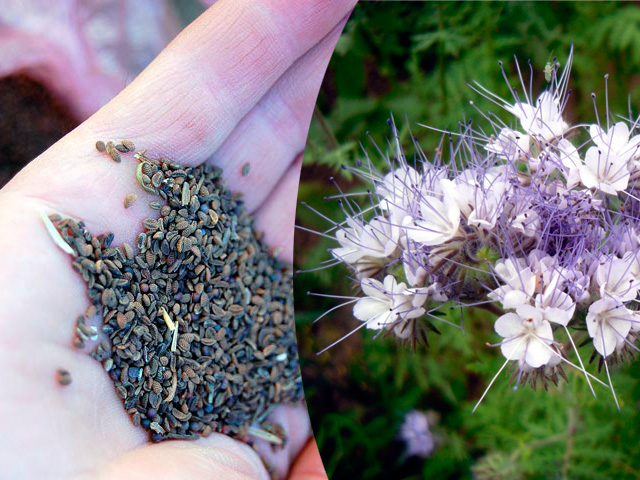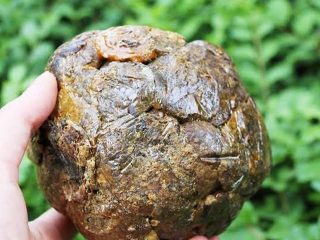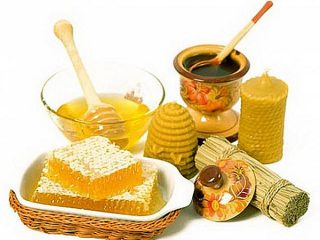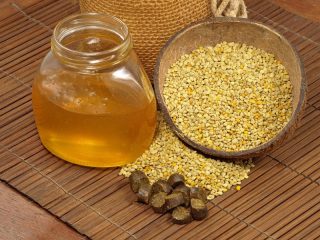Content
Phacelia honey plant is one of the favorite plants in the diet of bees. Delicate lilac buds with long, erect petals, like thorns, attract hardworking insects. In addition to being an excellent honey plant for bees, phacelia is also a popular forage crop.
Description of the honey plant
Phacelia is an annual plant from the Borage family. Some of its species can be biennial. The grass grows up to 0.5 m or more. This is a bushy branched melliferous culture, the stem is straight. Leaves are green, serrated. The flowers are small, pale blue or lilac. The stamens are long, extending beyond the flower calyx, like spines.
This honey plant tolerates frost and temperature changes well. But a sharp decrease in it leads to a decrease in the formation of nectar.
What types are there
More than 80 species of phacelia are known. Some of them are grown as fodder crops, fertilizers, honey plants. There are also decorative types.
The most popular types of melliferous phacelia:
- Phacelia tansy - an ornamental honey plant, densely covered with beautiful small flowers. Its thick, sweet aroma is especially appreciated.
- Phacelia twisted - a half-meter plant with small (5 mm in diameter) flowers. They form a curvature in the form of a wave at the ends of the stems. This species blooms from early June to late September. It is used as an ornamental and melliferous plant.
- Phacelia bell-shaped - low culture, no more than a quarter of a meter long. The flowers are medium in size, about 3 cm, the petals are collected in the form of bells. Their color is intense purple, blue. This type of phacelia is used as an ornamental plant and as a honey plant.
Benefits of growing phacelia as a honey plant
Phacelia is a honey plant that actively attracts bees with its aroma. He has high honey and nectar productivity. The grass takes root well even on arid soils. The long flowering period, from early June to late September, allows for the maximum amount of honey per season.
Agricultural applications
Phacelia melliferous is a good forage crop. It contains substances that contribute to the rapid weight gain in cattle. Also, honey grass is a good prophylactic agent for various diseases in animals.
Phacelia is sown in the fields to fertilize the soil. Its long, branched root helps to loosen the soil, saturating it with oxygen. As soon as the crops of the honey plant cover the ground with a thick carpet, they are mowed and left on the field. The cut grass releases nitrogen and other organic compounds. The following spring, fertile soil is obtained for growing organic vegetables. The melliferous phacelia helps to reduce the acidity of the soil, changing it to neutral.
Honey productivity
If you plant Phacelia melliferous near the apiary, you can increase the productivity of bees by 5 times. Insects willingly fly to bright, fragrant honey buds. Phacelia flowers bloom for the bees, luring them in with a strong scent.With a good harvest from 1 hectare of land sown with a melliferous crop, you can collect up to 1000 kg of honey per season.
Under unfavorable weather conditions, beekeepers receive from 150 kg of sweet delicacies from 1 hectare. Even if there are other melliferous crops nearby, bees will prefer phacelia. Honey from it turns out not sugary, fragrant, with a slight sourness. The product is no less useful than honey from linden, acacia or buckwheat.
Nectar productivity
This factor depends on climatic conditions and in the environment of which crops the phacelia melliferous grows. In the first half of summer, the nectar productivity of melliferous plants is the highest, it ranges from 250 kg per 1 hectare of crops.
In the second half of the summer season and in September, this figure drops to 180 kg per hectare of field land. In regions with long warm summers, nectar productivity reaches 0.5 tons per hectare. One phacelia melliferous flower produces up to 5 mg of nectar.
Growing the phacelia melliferous herb
Phacelia is an unpretentious plant; it can be sown in the southern regions from early spring to late autumn. Regardless of the climatic conditions of the region, it is best to plant the phacelia in mid-May.
What soil is suitable for growing phacelia
Phacelia grows on any soil, but fertile soils are suitable for a good and lush flowering. Before starting sowing, it is not worth digging up the soil, it is only slightly loosened. Phacelia melliferous does not tolerate stony, kaolin-rich soil. For sowing, ventilated, well-lit areas are chosen.
Seeds of melliferous grass are very small and germinate almost on the surface of the soil, the depth of their laying is not more than 2 cm. Organic fertilizers are applied to the soil a month before planting. After it is well moisturized.
Which type to give preference
Many varieties of phacelia are excellent honey plants. In central Russia, in Altai, in the Kemerovo region, in the southern regions of the country, beekeepers prefer to cultivate phacelia tansy, bell-shaped, twisted. These species tolerate the vagaries of the weather well, while their nectar productivity does not change.
When to sow the phacelia honey plant
As a fertilizer, a melliferous culture is sown several times a year: in late autumn, early spring, in summer. From the moment of sowing until the grass blooms, it takes about 45 days. Therefore, it is possible to sow a crop as a honey plant in late April or early May. The air temperature should not fall below + 7 ° С.
Care rules
Phacelia melliferous is an unpretentious culture that does not require special care. It grows well and blooms in the sun, in bad weather the formation of nectar slows down. The plant does not like excessive moisture. If the summer is rainy, the soil should be loosened regularly. If you feed the soil with organic additives before planting, the growth of the honey plant will accelerate, its buds will be larger, and the flowering time is longer.
Collection and preparation of seeds
Seed is collected from the phacelia planted in early spring. The growth and flowering stage must take place in a timely manner and in full. As soon as the honey plant fades away, the seed pods, filled with high-quality seed, ripen in place of the buds. The seeds obtained from the melliferous culture of spring sowing are larger and of higher quality than the later ones. They remain viable for 3 years.
How to determine the maturity of a seed pod:
- Changing the color of the spikelet to a darker one.
- The seed pod is more than half brown.
- With a light touch, the seeds begin to crumble.
It is important not to miss this moment, otherwise the honey grass will begin to lose seeds, self-seeding will result.If you collect the seed pods earlier, you will have to dry and shell them yourself. With early collection, the seeds quickly deteriorate, turn out to be defective, they have poor germination.
The collection of ripe spikelets of melliferous plants is carried out with gloves, since a dry plant can injure the skin of the hands. Seed pods are cut with pruning shears or scissors, placed in cardboard boxes. Seeds are harvested in dry, sunny weather. Damp, they quickly deteriorate.
After collecting, the seeds of the honey grass are dried by spreading them out on paper in one layer. The seeds should be kept in the shade in a well-ventilated area. Drafts should be excluded: honey plant seeds will simply scatter.
The dried seed pods are put in canvas bags and threshed with sticks. After the contents are sifted through a coarse sieve or wrapped around. The husks will separate and the seeds will fall onto the litter. They must be collected in cloth bags and stored in a cool dry place.
Useful properties of phacelia honey
Phacelia beekeeping products are not inferior in quality to linden honey. Harvested at the end of summer, the honey herb product is distinguished by good taste and delicate floral aroma. Its color is light yellow, transparent, over time it can acquire a greenish, blue or whitish tint. Immediately after collection, the consistency of honey is viscous, thick, over time it crystallizes.
The calorie content of the sweet product is 304 kcal per 100 g. It contains sucrose and fructose, enzymes, and water-soluble vitamins.
The sweet product is recommended for people during the period of difficult physical and mental stress, recovery from diseases and operations.
Phacelia honey has the following qualities:
- pain relievers;
- calming;
- wound healing;
- calming;
- fortifying;
- antipyretic.
It is used for gastritis with low acidity, for diseases of the ENT organs, including tuberculosis. Shown honey phacelia with dysbacteriosis, liver diseases, with cholelithiasis.
Phacelia honey will strengthen the immune system, supply the body with the necessary microelements: manganese, zinc, potassium, iron, calcium.
With regular intake of phacelia honey with warm water on an empty stomach, you can increase the acidity of the stomach, hemoglobin in the blood, immunity, and normalize sleep. If you start consuming honey 1-2 months before the start of the cold season, you can prepare your body, strengthen it and protect yourself from most harmful viruses.
Conclusion
Phacelia honey plant is a favorite plant of modern beekeepers. It develops in any weather conditions in the vicinity of various peduncles. The bees are happy to feast on its fragrant blue flowers filled with spicy nectar. The honey obtained from phacelia has medicinal and strengthening properties, it is used during colds, to strengthen the immune system.
